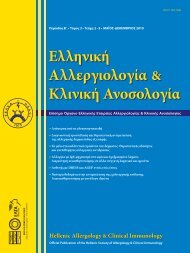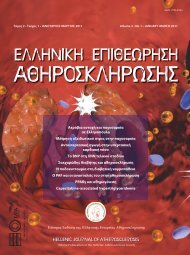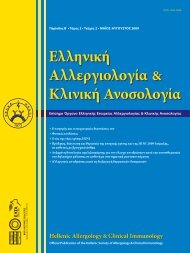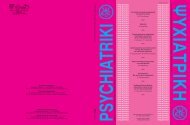334 C.I. Istokoglou et al PSYCHIATRIKI 21 (4), 2010big, tufted, red bush; its flower resembles the leucoiaand, if rubbed between the fingers, it producesa juice that resembles human blood. For this reasonthe plant has been named Androhaimon (humanblood)”. His contemporary physicians, Greek andRoman respectively, Galen and Plenius, repeated importantreferences to the plant of Dioscorides, whileother physicians of the time remarked that SaintJohn’s Wort was an excellent drug to provoke menstruation,and an antipyretic. Furthermore, Pleniusthe Roman, found it extremely effective for the healingof snake bites, when mixed with wine. Dioscorideswrites on Hypericum: «ΥΠΕΡΕΙΚΟΝ. ΟΙ ΔΕ ΑCΚΥΡΟΝΟΙ ΔΕ ΑCΚΥΡΟΪΔΕC, ΟΙ ΔΕ ΑΝΔΡΟCΑΙΜΟΝ. ΚΑΙΤΟΥΤΟ ΕCΤΙΝ ΕΙΔΟC ΥΠΕΡΙΚΟΥ ΔΙΑΦΕΡΟΝ ΚΛΩCΙΝ,ΦΡΥΓΑΝΩΔΕCΤΕΡΟΝ ΔΕ ΚΑΙ ΠΕΦΟΙΝΙΓΜΕΝΟΝ ΤΟΙCΦΥΛΛΟΙC ΛΕΠΤΟΙC, ΑΝΘΗ ΜΗΛΙΝΑ, ΚΑΡΠΟΝ ΔΕΟΜΟΙΟΝ ΥΠΕΡΕΙΚΩ, ΟΖΟΝΤΑ ΡΗΤΕΙΝΗΝ ΚΑΙ ΟΙΟΝΕΙΑΙΜΑCCΟΝΤΑ ΤΟΥC ΔΑΚΤΥΛΟΥC, ΤΟ CΠΕΡΜΑΩCΤΕ ΔΙΑ ΤΟΥΤΟ ΑΝΔΡΟCΑΙΜΟΝ ΚΑΛΕΙΤΑΙ. ΠΟΕΙΔΕ ΚΑΙ ΤΟΥΤΟΥ Ο ΚΑΡΠΟC ΠΡΟC ΙCΚΙΑΔΙΚΟΥCΠΕΙΝΟΜΕΝΟC ΜΕΘ’ΥΔΡΟΜΕΛΙΤΟC ΚΟΤΥΛΩ ΔΥΕΙΝ.ΑΓΕΙ ΔΕ ΧΟΛΩΔΗ ΚΑΙ ΚΟΠΡΙΑ ΠΟΛΛΑ CΥΝΕΧΩCΔΙΔΟΜΕΝΟC ΑΧΡΙ ΑΝ ΥΓΙΑCΘΩCΙΝ ΠΟΕΙ ΚΑΙΠΡΟC ΠΥΡΙCΑΥΤΑ ΕΠΙΠΛΑCΘΕΙC:», Φ. 145, σελ. 206ΠΕΡΙ ΥΛΗC ΙΑΤΡΙΚΗC, Ο ΕΛΛΗΝΙΚΟC ΚΩΔΙΚΑC 1,ΤΗC ΕΘΝΙΚΗC ΒΙΒΛΙΟΘΗΚΗC ΤΗC ΝΕΑΠΟΛΕΩC,ΕΙCΑΓΩΓΙΚΑ ΚΕΙΜΕΝΑ. 10–14In fact, most of the initial recorded referencescome from people that used herbs and physiciansthat lived in Greece and the Roman Empire,where the plant was known with its Greek name"Ypericon". Like most famous herbs, the healingproperties of which have been appreciated forcenturies, the benefits from Saint John’s Wort havebeen known beyond doubt, and passed on frommouth to mouth through generations of votanologistsand healers, before history itself. For instance,the effectiveness of Saint John’s Wort for the healingof wounds and inflammations was surely knownfor some time then. Most of the early healers followedthe old popular belief that the natural characteristicsof any therapeutic drug were related tothe conditions under which treatment is more effective.The oil extracted flowers and plants fromlooked like blood, made the ancient people thatthink this plant would be effective in the treatmentof wounds and inflammatory infections – and thatwas true. 15–19Paracelsus was the first to discover the importanceof sterilizing Hypericum with boiling, while recommendingit for the treatment of ill temper and anxiety.Since then, Hypericum is an ingredient of a “naturaldrug”.Furthermore, should it be noted that during the6th century, as mentioned in an inscription, theplant has been immortalized by the Celt SaintColoumba, who was devoted to Saint John theBaptist. Saint Coloumba, who founded monasteriesall over Ireland and Scotland, is said that carried abranch of Hypericum or Saint John’s Wort with himeverywhere he went, in honour of the martyredSaint. Furthermore, according to a tradition, hebrought Saint John’s wort with him as spiritual protectionduring his long and dangerous journeys asa missionary to Celtic tribes.Until the Middle Ages, Hypericum formed a partof many summer solstice rituals. In the eve of SaintJohn’s day, for instance, people used to hang garlandsmade of the leaves and flowers of this plantover the doors of houses and churches, to protectthem from witches and evil spirits. People also usedto put branches of this plant under their pillows inthe eve of Saint John’s day, believing that the Sainthimself would appear to them in a dream, give themhis blessing, and keep death away for the year tocome. The dried leaves of the plant were consideredto be protective talismans, used like bookmarkswithin the Bible and prayer books.It is easy for one to understand the way in whichseveral of these ancient superstitions came up. Thisplant flourishes mildly and copiously, near the dateof the summer solstice, an important time of planting,accompanied by a wealth of pagan, indigenousand early religious rituals. People performed sacrificesand offerings to ancient Gods, like the Sun andthe Earth, for the fertility of the season. Prayers weremade to the Gods of the West, to bring a copiousharvest during the Fall.Furthermore, this is the time when we celebratethe birthday of Saint John the Baptish, who was
PSYCHIATRIKI 21 (4), 2010 HYPERICUM PERFORATUM 335tragically beheaded, and his head was offered toSalome. This last part, along with the fact that theplant’s oil leave blood-like stains on the fingers andthe hands of those gathering it, provoked someinterest regarding certain of the magical and sinisterand implicits regarding Saint John’s Plant.Moreover, in antiquity, it was believed that SaintJohn’s Wort offered protection from evil spirits andbad luck; this belief may have originated partlyfrom the plant’s initial use by traditional healers asa drug for the so-called “melancholy”, or troubledminds. Today, we call these conditions “depression”or “anxiety”.Indeed, Hypericum has recently attracted considerableattention, for its anti-depressant properties.In any case, during antiquity, the effectiveness ofthe use of this plant for the treatment of any mentalor emotional condition, has been undoubtedlyproven, although not fully appreciated, as a side-effectof one of its more common uses. Ancient healersand herbologists, who usually treated woundsand infections using this plant, possibly noticedthat the plant also had a tranquillizing effect, especiallyin its clear oil form, when applied directlyand absorbed by the skin, and in its liquid form (derivedby the steam created by its leaves and flowers– called a “concoction” in traditional herbology)administered orally.Later, the Crusaders brought the plant with themto protect themselves by witchcraft; they also usedsoaked flowers and leaves as ointments to treat thewounds of battle. Naturally, until the Middle Ages,all these therapeutic uses were common practice.The Knights of the Order of Saint John of Jerusalemregularly used cataplasms made of mashed flowersand leaves of this plant, to contain bleeding and healthe wounds of battle, during the 11th, 12th, and 13thcentury. During the same period, the people sufferingfrom rage, or believed to have been possessedby daemons, often were administered concoctionsof the plant, or inhaled its slightly bitter and acidsmell. 20,21In 1618, Hypericum was one of the therapeuticplants to be mentioned in the first LondonPharmacopeia. In England, the plant has been madeparticularly known by Nicholas Culpeper (1616–1654),the famous botanologist.The American settlers that immigrated to England,France, and Germany, brought the plant to theNorth Eastern states of the USA, and from there, ithas spread to the argest part of the country, as thesetters moved towards the South and the West. Onehundred years later, during the Eclectic Period, thegolden age of American herbology, known herbologistslike John King and Finley Ellingwood markedthat the use of Hypericum had now spread beyondthe healing of wounds, and that the drug was nowused as a diuretic, astringent, tranquilliser, and forthe treatment of depression. Nevertheless, duringthe 20th century, Hypericum became known for itsvast treatment applications, mainly as an anti-depressant,in both sides of the Atlantic.The treatment indications of the Hypericum, fromantiquity until today, is common cold, the flu, infectiousmononucleosis, dysmenorrhea, menopause,premenstrual dystonia, carpal tunnel syndrome, lumbago,strains, carbuncles, subcutaneous haematoma,burns of all natures, insect bites, obesity, anxiety, insomnia,seasonal emotional disturbance, and, finally,mild and moderate depression. 21,22DiscussionBased on bibliography, it seems that theHypericum has been known since antiquity forits vast treatment applications. Today, especiallyin the USA, United Kingdom and Germany, it isadministered for the treatment of mild and moderatedepression. Its Pharmacodynamics andPharmacokinetics have been extensively studied,and many research protocols are under developmentfor the vaster treatment of many seriousconditions like cancer, HIV and hepatitis, as well ascomparative studies of Hypericum with the activityof tricyclic antidepressants (TCA), and serotoninereuptake inhibitors (SSRI). According to relativelyolder studies, the Hypericum has equal activity withamitryptiline, fluoxetine and maprotiline, whileclearly exceeds activity versus placebo. Accordingto its possible mechanism of activity, it is consid-
- Page 5:
PSYCHIATRIKIQuarterly journal publi
- Page 9 and 10:
PSYCHIATRIKI 21 (4), 2010 277Άρθ
- Page 11 and 12:
PSYCHIATRIKI 21 (4), 2010 279Resear
- Page 13 and 14:
PSYCHIATRIKI 21 (4), 2010 HOSPITAL
- Page 15 and 16: PSYCHIATRIKI 21 (4), 2010 HOSPITAL
- Page 17 and 18: PSYCHIATRIKI 21 (4), 2010 HOSPITAL
- Page 19 and 20: PSYCHIATRIKI 21 (4), 2010 287Resear
- Page 22 and 23: 290 P. TZOURAMANIS et al PSYCHIATRI
- Page 24 and 25: 292 P. TZOURAMANIS et al PSYCHIATRI
- Page 26 and 27: 294 PSYCHIATRIKI 21 (4), 2010Resear
- Page 28 and 29: 296 M. VLASSOPOULOS et al PSYCHIATR
- Page 30 and 31: 298 M. VLASSOPOULOS et al PSYCHIATR
- Page 32 and 33: 300 M. VLASSOPOULOS et al PSYCHIATR
- Page 34 and 35: 302 M. VLASSOPOULOS et al PSYCHIATR
- Page 36 and 37: 304 PSYCHIATRIKI 21 (4), 2010Resear
- Page 38 and 39: 306 H. LAZARATOU et al PSYCHIATRIKI
- Page 40 and 41: 308 H. LAZARATOU et al PSYCHIATRIKI
- Page 42 and 43: 310 H. LAZARATOU et al PSYCHIATRIKI
- Page 44 and 45: 312 H. LAZARATOU et al PSYCHIATRIKI
- Page 46 and 47: 314 H. LAZARATOU et al PSYCHIATRIKI
- Page 48 and 49: 316 C. Kouimtsidis PSYCHIATRIKI 21
- Page 50 and 51: 318 C. Kouimtsidis PSYCHIATRIKI 21
- Page 52 and 53: 320 C. Kouimtsidis PSYCHIATRIKI 21
- Page 54 and 55: 322 C. Kouimtsidis PSYCHIATRIKI 21
- Page 56 and 57: 324 PSYCHIATRIKI 21 (4), 2010Specia
- Page 58 and 59: 326 B.J. HAVAKI-KONTAXAKI et al PSY
- Page 60 and 61: 328 B.J. HAVAKI-KONTAXAKI et al PSY
- Page 62 and 63: 330 B.J. HAVAKI-KONTAXAKI et al PSY
- Page 64 and 65: 332 PSYCHIATRIKI 21 (4), 2010Genera
- Page 68 and 69: 336 C.I. Istokoglou et al PSYCHIATR
- Page 70 and 71: 338 C.I. Istokoglou et al PSYCHIATR
- Page 72 and 73: 340 PSYCHIATRIKI 21 (4), 2010• 10
- Page 74 and 75: SUBMISSIONPapers either in English
- Page 76 and 77: ΥΠΟΒΟΛΗ ΕΡΓΑΣΙΩΝΟι
- Page 78: ΣΥΝΟΔΕΥΤΙΚΟ ΕΝΤΥΠΟ













